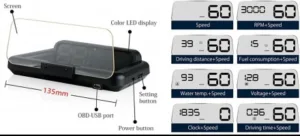Moji, Inc. (Shibuya, Tokyo, Japan) is about to offer the latest model in the company’s NeoTokyo line of aftermarket HUDs for automotive applications.
The OBD-X1 product does not use a high resolution graphic display as is common in other commercially available automotive HUD products. Rather, the device produces an image that is composed of “fixed” alphanumeric characters. The information that can be presented by the display appears in three defined areas. Examples of the types of information offered in this “simplified” format includes the following.
- Multipurpose Display Area: tachometer (RPM), voltage, drive distance, water temperature (in ? or ?), fuel consumption rate and clock.
- Icons Area: water temperature, voltage, gear shift recommendation, speed warning, long drive time warning and engine problem warning.
- Speed Display Area: speed units switchable between km/h and mph.
The left hand portion of the figure below illustrates the features of the HUD device. The center portion of the figure below illustrates several of the possible images that can be displayed by the device. The right hand portion of the figure illustrates the HUD in operation.
 Left: features of the HUD NeoTokyo OBD-X1 product. Center: examples of information that can be presented by the HUD. Right: the HUD in operation. Click for higher resolution
Left: features of the HUD NeoTokyo OBD-X1 product. Center: examples of information that can be presented by the HUD. Right: the HUD in operation. Click for higher resolution
A video appended to the end of this article illustrates the HUD in operation. Other features and specifications for the HUD include the following.
- Installing the HUD does not require any tools and is represented as simple.
- The HUD is compatible with vehicles that comply with either the OBD-II or EOBD standards. That is, vehicles that have a 12V battery. In the US/EU regions, this includes vehicles that are 2003 or newer. In other regions, 2008 or newer. Since the operating voltage is between 11V and 18V, the HUD is not compatible with 24V vehicles.
- Current draw while in the sleep mode is less than 30mA.
- Includes an automatic power on/off function that is synchronized to the vehicle’s engine.
- The HUD uses a high luminance, multicolor LED display.
- The projected image size is 90mm x 20mm.
- The brightness of the HUD is adjusted automatically. The display is reported as readable under a wide range of lighting conditions.
- Viewing angle is 60 degrees horizontal by 15 degrees vertical.
- The HUD product has a built in, fold down screen.
- Product dimensions: Screen down: 135mm x 68mm x 30mm. Screen up: 135mm x 68mm x 56mm.
- Screen transmittance: 96%. The screen is described as not obstructing the driver’s forward field of vision.
- Operating temperature: -40°C to +80°C. The device has the durability to withstand the temperature environment of a vehicle dashboard.
- Operating humidity: 10% to 95%.
Company literature notes that the OBD-X1 HUD product reads data directly from the vehicle’s on board computer. Conventional, built-in speedometers, on the other hand, typically derive data from sensors that detect the rotational speed of the driveshaft. The difference in data sources can result in the report of different speeds by the two methods. It is possible, however, to eliminate any such the discrepancy by use of the HUD device’s coefficient settings.
The company has chosen to launch a Kickstarter campaign on May 14th to fund mass production and marketing of the product. The campaign can be found here. At the time this article is written, $2,556 has been pledged by 19 backers against a goal of $899. Since this inexplicably small goal has been reached well before the all-or-nothing deadline of June 13th, the project will fund. Moji has stated that production of the HUD has already started under contract with a factory in China. Moji will market the product and provide user support.
Products are planned to ship to all Kickstarter backers during August. The HUD NeoTokyo OBD-X1 product is scheduled to be made available to the general public at a list price of $180. This price point is much more affordable than the standard head up displays from automobile manufacturers. –Arthur Berman

